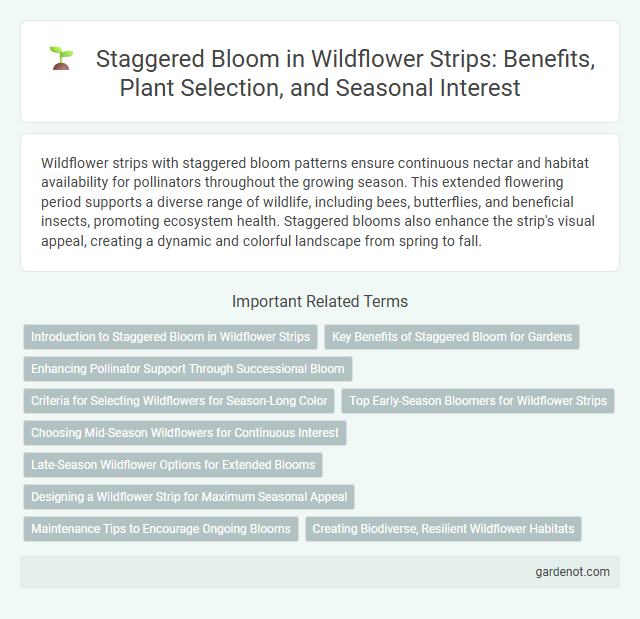Wildflower strips with staggered bloom patterns ensure continuous nectar and habitat availability for pollinators throughout the growing season. This extended flowering period supports a diverse range of wildlife, including bees, butterflies, and beneficial insects, promoting ecosystem health. Staggered blooms also enhance the strip's visual appeal, creating a dynamic and colorful landscape from spring to fall.
Introduction to Staggered Bloom in Wildflower Strips
Staggered bloom in wildflower strips ensures continuous flowering by planting species with varying bloom times, enhancing habitat diversity and pollinator support throughout the growing season. This approach maximizes ecological benefits by providing consistent nectar and pollen sources, promoting sustained pollinator activity. Proper selection and arrangement of native wildflower species create a dynamic, vibrant ecosystem that supports biodiversity and improves overall habitat resilience.
Key Benefits of Staggered Bloom for Gardens
Staggered bloom in wildflower strips ensures continuous floral displays from spring through fall, supporting pollinators with consistent nectar sources. This extended blooming period enhances biodiversity by attracting a variety of insects, birds, and other wildlife throughout the growing season. Gardens benefit from prolonged aesthetic appeal and improved ecosystem resilience due to diverse plant species flowering at different times.
Enhancing Pollinator Support Through Successional Bloom
Staggered bloom in wildflower strips extends the availability of nectar and pollen throughout the growing season, directly enhancing pollinator support by ensuring continuous food resources. Successional bloom patterns promote diverse pollinator populations, including bees, butterflies, and hoverflies, by catering to their varying life cycles and dietary needs. This strategic planting boosts ecosystem resilience and supports biodiversity within agricultural landscapes.
Criteria for Selecting Wildflowers for Season-Long Color
Selecting wildflowers for season-long color in a staggered bloom wildflower strip requires prioritizing species with varied flowering periods that collectively span spring through fall. Opt for native perennials and annuals known for distinct peak blooms, such as purple coneflower (Echinacea purpurea) for mid-summer, black-eyed Susan (Rudbeckia hirta) for late summer, and goldenrod (Solidago spp.) for early fall color. Ensuring a mix of early, mid, and late-season bloomers enhances continuous visual interest and supports pollinator activity across multiple months.
Top Early-Season Bloomers for Wildflower Strips
Early-season bloomers like Crocus, Snowdrops, and Hellebores ensure a staggered bloom in wildflower strips, providing vital nectar sources for pollinators emerging after winter. These top early-season plants establish a foundation for biodiversity, supporting bees and butterflies during critical foraging periods. Strategically planting staggered flowering species extends the bloom period, enhancing ecological resilience and habitat value in wildflower strips.
Choosing Mid-Season Wildflowers for Continuous Interest
Selecting mid-season wildflowers such as Purple Coneflower, Black-eyed Susan, and Butterfly Weed ensures a vibrant staggered bloom in wildflower strips. These species provide continuous color and attract pollinators from late spring to early fall. Incorporating diverse mid-season blooms optimizes ecological balance and maintains aesthetic appeal throughout the growing season.
Late-Season Wildflower Options for Extended Blooms
Selecting late-season wildflowers such as New England Aster, Goldenrod, and Ironweed ensures a staggered bloom in wildflower strips, extending floral display well into fall. These species attract late-season pollinators like monarch butterflies and native bees, supporting biodiversity during critical times. Incorporating diverse perennials with varied peak bloom times guarantees sustained nectar sources and visual interest across the growing season.
Designing a Wildflower Strip for Maximum Seasonal Appeal
Staggered bloom in a wildflower strip ensures continuous color and habitat value from early spring through late fall by carefully selecting species with overlapping flowering periods. Incorporate native wildflowers such as Black-eyed Susan, Purple Coneflower, and Aster, which bloom sequentially and attract pollinators throughout the growing season. Strategic planting enhances biodiversity, supports wildlife, and creates an aesthetically dynamic landscape that evolves naturally over time.
Maintenance Tips to Encourage Ongoing Blooms
To encourage ongoing blooms in a wildflower strip with staggered bloom periods, regularly deadhead spent flowers to prevent seed formation and promote continued flowering. Maintain optimal soil moisture by watering deeply during dry spells, ensuring the roots remain healthy without waterlogging. Periodic thinning of dense patches helps improve air circulation and sunlight penetration, supporting vibrant and prolonged floral displays.
Creating Biodiverse, Resilient Wildflower Habitats
Staggered bloom in wildflower strips enhances biodiversity by providing continuous floral resources throughout the growing season, supporting diverse pollinator species and wildlife. Strategic planting of species with varying bloom times increases habitat resilience against environmental stress and climate variability. This approach fosters ecological stability, promoting sustainable ecosystems and improving overall habitat health.
Staggered bloom Infographic

 gardenot.com
gardenot.com